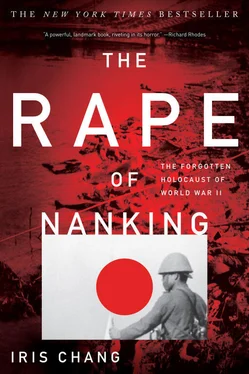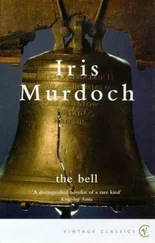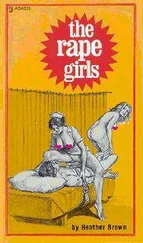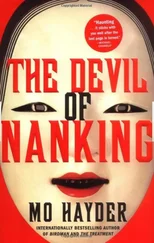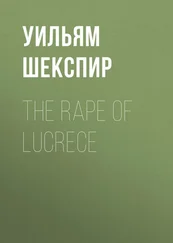—WILLIAM C. KIRBY, Professor of Modern Chinese History and Chairman of the Department of History, Harvard University
THE CHRONICLE of humankind’s cruelty to fellow humans is a long and sorry tale. But if it is true that even in such horror tales there are degrees of ruthlessness, then few atrocities in world history compare in intensity and scale to the Rape of Nanking during World War II.
Americans think of World War II as beginning on December 7, 1941, when Japanese carrier-based airplanes attacked Pearl Harbor. Europeans date it from September 1, 1939, and the blitzkrieg assault on Poland by Hitler’s Luftwaffe and Panzer divisions. Africans see an even earlier beginning, the invasion of Ethiopia by Mussolini in 1935. Yet Asians must trace the war’s beginnings all the way back to Japan’s first steps toward the military domination of East Asia—the occupation of Manchuria in 1931.
Just as Hitler’s Germany would do half a decade later, Japan used a highly developed military machine and a master-race mentality to set about establishing its right to rule its neighbors. Manchuria fell quickly to the Japanese, who established their government of Manchukuo, ostensibly under their puppet, the deposed emperor of China, but in fact run by the Japanese military. Four years later, in 1935, parts of Chahar and Hopeh were occupied; in 1937 Peking, Tientsin, Shanghai, and finally Nanking fell. The decade of the thirties was a hard one for China; indeed, the last Japanese would not be routed from Chinese soil until the end of World War II in 1945.
No doubt, those fourteen years of domination by the Japanese military were marked by countless incidents of almost indescribable ruthlessness. We will never know everything that happened in the many cities and small villages that found themselves prostrate beneath the boot of this conquering force. Ironically, we do know the story of Nanking because some foreigners witnessed the horror and sent word to the outside world at the time, and some Chinese survived as eyewitnesses. If one event can be held up as an example of the unmitigated evil lying just below the surface of unbridled military adventurism, that moment is the Rape of Nanking. This book is its story.
The broad details of the Rape are, except among the Japanese, not in dispute. In November 1937, after their successful invasion of Shanghai, the Japanese launched a massive attack on the newly established capital of the Republic of China. When the city fell on December 13, 1937, Japanese soldiers began an orgy of cruelty seldom if ever matched in world history. Tens of thousands of young men were rounded up and herded to the outer areas of the city, where they were mowed down by machine guns, used for bayonet practice, or soaked with gasoline and burned alive. For months the streets of the city were heaped with corpses and reeked with the stench of rotting human flesh. Years later experts at the International Military Tribunal of the Far East (IMTFE) estimated that more than 260,000 noncombatants died at the hands of Japanese soldiers at Nanking in late 1937 and early 1938, though some experts have placed the figure at well over 350,000.
This book provides only the barest summary of the cruel and barbaric acts committed by the Japanese in the city, for its aim is not to establish a quantitative record to qualify the event as one of the great evil deeds of history, but to understand the event so that lessons can be learned and warnings sounded. Differences in degree, however, often reflect differences in kind, and so a few statistics must be used to give the reader an idea of the scale of the massacre that took place in 1937 in a city named Nanking.
One historian has estimated that if the dead from Nanking were to link hands, they would stretch from Nanking to the city of Hangchow, spanning a distance of some two hundred miles. Their blood would weigh twelve hundred tons, and their bodies would fill twenty-five hundred railroad cars. Stacked on top of each other, these bodies would reach the height of a seventy-four-story building.
Using numbers killed alone, the Rape of Nanking surpasses much of the worst barbarism of the ages. The Japanese outdid the Romans at Carthage (only 150,000 died in that slaughter), the Christian armies during the Spanish Inquisition, and even some of the monstrosities of Timur Lenk, who killed 100,000 prisoners at Delhi in 1398 and built two towers of skulls in Syria in 1400 and 1401.
It is certainly true that in the twentieth century, when the tools of mass murder were fully refined, Hitler killed about 6 million Jews, and Stalin more than 40 million Russians, but these deaths were brought about over some few years. In the Rape of Nanking the killing was concentrated within a few weeks.
Indeed, even by the standards of history’s most destructive war, the Rape of Nanking represents one of the worst instances of mass extermination. To imagine its comparative size, we must brace ourselves for a few more statistics. The death toll of Nanking—one Chinese city alone—exceeds the number of civilian casualties of some European countries for the entire war. (Great Britain lost a total of 61,000 civilians, France lost 108,000, Belgium 101,000, and the Netherlands 242,000.) Air bombing is considered by those who reflect on these things one of the most awesome instruments of mass destruction. Yet even the worst air attacks of the war did not exceed the ravages of Nanking. It is likely that more people died in Nanking than in the British raids on Dresden and the fire storm that followed. (The figure 225,000 was accepted internationally at the time, but more objective accounts now place the number of Dresden casualties at 60,000 dead and at least 30,000 injured.) Indeed, whether we use the most conservative number—260,000—or the highest—350,000—it is shocking to contemplate that the deaths at Nanking far exceeded the deaths from the American raids on Tokyo (an estimated 80,000–120,000 deaths) and even the combined death toll of the two atomic blasts at Hiroshima and Nagasaki by the end of 1945 (estimated at 140,000 and 70,000, respectively).
The Rape of Nanking should be remembered not only for the number of people slaughtered but for the cruel manner in which many met their deaths. Chinese men were used for bayonet practice and in decapitation contests. An estimated 20,000–80,000 Chinese women were raped. Many soldiers went beyond rape to disembowel women, slice off their breasts, nail them alive to walls. Fathers were forced to rape their daughters, and sons their mothers, as other family members watched. Not only did live burials, castration, the carving of organs, and the roasting of people become routine, but more diabolical tortures were practiced, such as hanging people by their tongues on iron hooks or burying people to their waists and watching them get torn apart by German shepherds. So sickening was the spectacle that even the Nazis in the city were horrified, one proclaiming the massacre to be the work of “bestial machinery.”
Yet the Rape of Nanking remains an obscure incident. Unlike the atomic explosions in Japan or the Jewish holocaust in Europe, the horrors of the massacre at Nanking remain virtually unknown to people outside Asia. The massacre remains neglected in most of the historical literature published in the United States. A thorough examination of secondary-school history textbooks in the United States revealed that only a few even mention the Rape of Nanking. And almost none of the comprehensive, or “definitive,” histories of World War II read by the American public discusses the Nanking massacre in great detail. For instance, no photograph of the event, not even one word, appears in The American Heritage Picture History of World War II (1966), which for many years was the best-selling single-volume pictorial history of the war ever published. Nor can a word of the massacre be found in Winston Churchill’s famous Memoirs of the Second World War (1959) (1,065 pages) or in Henri Michel’s classic Second World War (1975) (947 pages). The Rape of Nanking is mentioned only twice in Gerhard Weinberg’s massive A World at Arms (1994) (1,178 pages). Only in Robert Leckie’s Delivered from Evil: The Saga of World War II (1987) (998 pages) did I find a single paragraph about the massacre: “Nothing the Nazis under Hitler would do to disgrace their own victories could rival the atrocities of Japanese soldiers under Gen. Iwane Matsui.”
Читать дальше
